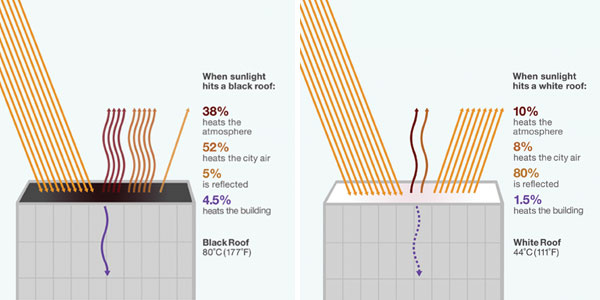Cool Roofs for Hot Projects
Cool Roofing:
A Win-Win for Building Owners and the Environment
When properly installed and maintained, cool roofs provide numerous benefits that contribute to the health of a community, to the occupants of the building and to the owner's pocket book.
Among the benefits to the building occupants and owner are:
- Improved comfort for occupants. The building's interior is subject to less thermal flux and stays cooler during the warm season.
- Energy savings from reduced cooling energy loads.
- Longer air conditioning unit life resulting from decreased use.
- Increased roof durability due to reduced thermal flux, as cool roofs can stay up to 70 °F cooler than dark roofs.1
Cool roofs are distinguished among energy conservation measures because of the many environmental benefits they can provide. A crucial benefit of cool roofs is their ability to help mitigate the urban heat island effect. The urban heat island effect is a phenomenon that is characterized by a measured increase in the ambient air temperature in cities over their surrounding rural areas. This is due to roofs and other non-reflective surfaces that absorb and trap solar radiation-or heat. Cities can be 2° to 8°F warmer than their surrounding areas because this trapped heat gradually warms the ambient air temperature throughout the day and nighttime hours warming the urban core without any opportunity for temperatures to drop at night.2 Cool roofs help improve urban conditions by:
- Contributing to cooler ambient temperatures by immediately reflecting solar radiation back into the atmosphere before it can degrade to heat, as well as reemitting a portion of infrared light.
- Indirectly reducing air-conditioning use by lowering the ambient air temperatures.
- Improving grid stability and increasing peak energy savings by reducing the need for air-conditioning at the hottest times of the year.
Improving the Air We Breathe
Through mitigation of the urban heat island effect with the reduction of ambient air temperatures, cool roofs also improve air quality. Smog is created by photochemical reactions of air pollutants, and these reactions increase at higher temperatures. In Los Angeles alone, mitigation measures that reduce the average air temperature by 5 °F could yield a 12 percent reduction in smog (ozone) worth $360 million/year.3 Lower ambient air temperatures and the subsequent improved air quality also result in a reduction in heat-related and smog-related health issues, including heat stroke and asthma. In addition to the reduction of greenhouse gas emissions such as CO2, by conserving electricity for air conditioning cool roofs reduce the emission of nitrogen dioxide and sulfur dioxide particulates from power plants.
 |
This diagram compares how solar radiation and heat are distributed on a black versus a white roof. Images courtesy of Global Cool Cities Alliance Design by Imaginary Office |









